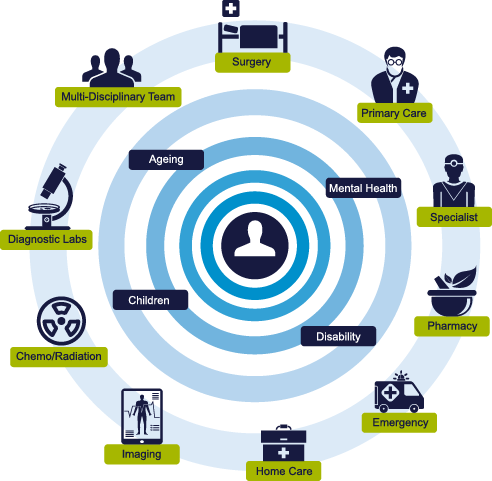Setting the Scene
The Irish healthcare system is at a key juncture.
On one hand, Ireland has in the past years experienced many of the same challenges as other developed countries:
- Growing population
- Increase in chronic disease
- Multiple co-morbidities
- Increased cost of healthcare provision
- Historical lack of technology investment
However, on the other hand, significant positive momentum is building up to start transforming the entire healthcare model for Ireland, in line with global best practice in healthcare delivery and innovation.
- Life expectancy in Ireland has increased and is above the EU average. We are living longer through advances in medicine, technology and improved models of care
- Mortality rates from circulatory system diseases fell by 30% between 2004 and 2013 and cancer death rates decreased by 10%
- Transport accident mortality rates have fallen by 55% in the past decade, infant mortality by 29%, and suicide rates by 13%
- The average length of stay for the remaining inpatients has shown a gradual decline to 5.4 days in 2013 which represents a reduction of 13.5% since 2004
- Development and publishing of the Ireland eHealth Strategy in 2013 and the HSE Corporate Plan for 2015-2017
- Planning and mobilisation of the Health Reform programme, and as part of this, the definition of Integrated Care Programmes, and establishment of new Hospital Groups and Community Health Organisations.
At the same time, significant steps have been made in the wider government context. A major milestone was the publication of the National Digital Strategy for Ireland in 2013 which focuses on “doing more with digital” and sets out a vision and steps to do more online. Also, more recently, the OGCIO Public Service ICT Strategy was published which sets out to deliver better outcomes and efficiency through innovation and excellence in ICT and for ICT to enable better sharing and integration across all of Government.

There are also compelling examples of success in the health system from deploying new technology to benefit the patient, the clinician and the system – such as the health information exchange (for example, HealthLink), successful pilot on eReferrals, national implementation of PACS solution known as NIMIS, and out-of hours General Practitioner support through the use of integrated systems. More broadly, too, there are strong positives: the Irish economy is growing again, the nation’s population is still relatively young compared with our European peers, and proliferation of and familiarity with consumer and digital technology in all age and demographic groups is overwhelming, creating a fruitful ground for greater use of technology enablement in delivering healthcare services.
Against this context, there is an opportunity now to accelerate the implementation of the overall Reform Programme with eHealth enabled capabilities, and create a more integrated, more efficient and truly patient centric healthcare service. To support this effectively, our ambition is to re-position technology delivery capability within the health service as a value-add, integral part of the healthcare provision, not ‘ICT’ outside the ‘businesses’. This is reflected in the title of this document, Knowledge & Information Strategy.
Furthermore, to mark the start of this journey, the new name of the technology delivery function within the HSE will be Knowledge & Information (K&I). This name appropriately reflects the new positioning of the role that technology delivery capability within the HSE plays in enabling integrated care delivery. This function is responsible for the delivery of this strategy as well as providing the ongoing support and development of existing information technology services. The function is led by the HSE CIO, supported by the Office of the CIO and the Knowledge & Information Senior Management Team.
This strategy does not solely impact the Knowledge & Information function. eHealth priorities and benefits realisation must be driven by Clinical and Operational leadership. The Knowledge & Information strategy outlines how Clinical leadership for the programme will be instituted with a number of senior clinicians and operational leaders having been consulted in its formation. This engagement process is described in the Appendix.
